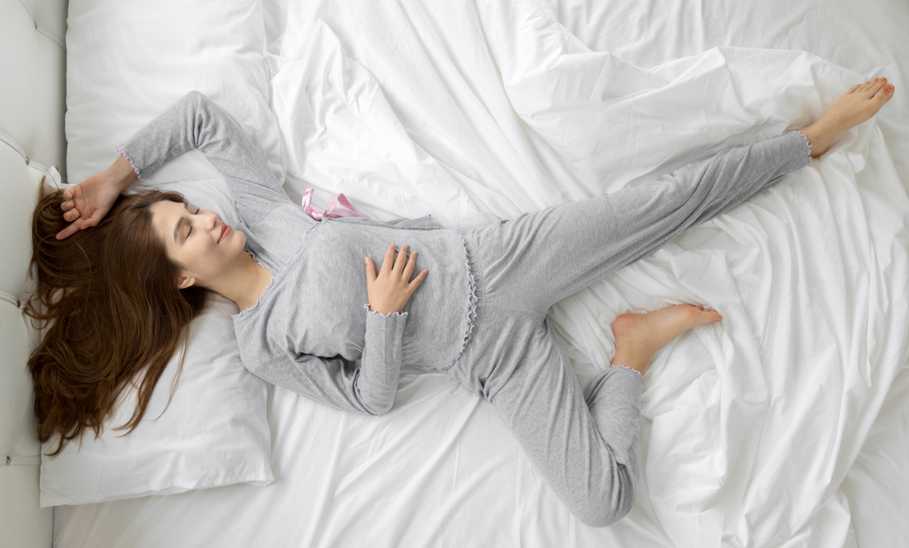The Best Sleeping Position for A Comfortable Night’s Sleep


Our evaluations and opinions are not influenced by our advertising relationships, but we may earn a commission from our partners’ links. This content is created by TIME Stamped, under TIME’s direction and produced in accordance with TIME’s editorial guidelines and overseen by TIME’s editorial staff. Learn more about it.
The Centers for Disease Control and Prevention (CDC) says adults should get 7 or more hours of sleep a night. Your sleep position—along with other factors such as health conditions, sleep environment, and your age—can affect how well you sleep at night.
But what position should you sleep in? Turns out, the best sleep position will vary depending on factors such as any health conditions you have, your mattress, any pain you’re experiencing, and personal preference.
I spoke with Sean Ormond, MD, an anesthesiologist and interventional pain management specialist at Atlas Pain Specialists in Glendale, Arizona to explain the best sleeping positions for health conditions and personal comfort.
Sleep position is more than just for comfort. It can affect many different aspects of your health, including:
Side sleeping is the preferred position for the majority of people, according to research. “It's particularly beneficial during pregnancy for improving circulation to the heart,” says Dr. Ormond.
Research shows sleeping on your left side can also decrease acid reflux because your stomach is above your esophagus. Sleeping on your side can also prevent snoring. In a study of 21 people without sleep apnea, researchers found side sleeping decreased the time and intensity of snoring.
Side sleeping can also help if you have back pain, according to Mayo Clinic. Place a pillow between your legs to protect your knees and keep your spine aligned. (Knee pillows are particularly helpful.) Sleeping on your side may also help if you have neck pain, because it can protect your spine—in this case, your cervical spine. Sleeping with a contoured pillow with higher sides, or a pillow made of latex material can be a good choice for preventing neck pain while sleeping. A pillow height of 7 to 11 centimeters (2.75 to 4.3 inches) was also shown to be the most beneficial for decreasing neck pain.
Of course, like other sleep positions, everyone is unique and side sleeping may not work for you even if you are dealing with concerns such as back pain or heartburn.
“For individuals with hip or shoulder pain, adjusting the mattress firmness or adding a pillow between the knees can help align the hips and reduce pain,” explains Dr. Ormond. “A thicker pillow can be a game-changer here, helping keep your neck and spine straight.” Try using different pillows for side sleepers or mattress toppers to see if something works for you.
“Often considered the best position for spinal alignment, back sleeping can reduce pressure on the discs and allow the neck, head, and spine to rest in a neutral position,” says Dr. Ormond. Back-sleeping is especially beneficial if you have certain types of chronic pain, including low back pain, Dr. Ormond adds. If you’re dealing with back pain, try putting a pillow under your knees so your spine can maintain good curvature, and reduce further aches and pain. Sleep with a supportive pillow—research shows one that supports the cervical curve of the spine, such as an orthopedic pillow, can help with pain. You can find more information in our guides on pillows for neck pain relief and how to sleep on your back.
One other perk of back sleeping: Research says it might help prevent facial wrinkles since you’re not squishing your face into the pillow or mattress—the fancy term is mechanical compression—while you sleep. “Plus, it helps your night creams stay put rather than rubbing off on your pillow,” adds Dr. Ormond.
However, back sleeping can worsen snoring and sleep apnea. Snoring can happen for a number of reasons. As you enter deep sleep, your soft palate, tongue, and throat muscles relax, which can partially block your airway. Snoring can also be a risk factor for sleep apnea, where you have frequent pauses in breathing throughout the night that cause you to wake up a lot.
If you’re a stomach sleeper already, you may find it’s the most comfortable way you can fall asleep. But Dr. Ormond says stomach sleeping isn’t generally recommended because it can lead to neck and back pain because of poor alignment in your spine. Stomach sleeping places the most stress on your body. When you sleep on your stomach, you also need to turn your head to the side, which can cause neck pain.
“Generally, stomach sleeping isn’t the best if acid reflux is a concern—it tends to increase pressure on your stomach, pushing acid up,” says Dr. Ormond.
But if stomach sleeping is unavoidable for you, try placing a thin pillow under the lower abdomen to help reduce back strain, Dr. Ormond explains. Sleeping without a pillow, or with a thin pillow, can also help because your neck isn’t pressed up at an angle from lying on a plush pillow. (More low-profile pillows for side sleepers can be found in our guide.) It also helps if you’re sleeping on a firm, supportive mattress where your hips aren't sinking into the bed.
Finding the perfect sleep position for you is just that—it’s up to your own preferences, taking into account comfort and any health conditions you have.
For instance, while you may love sleeping on your back, it’s not recommended in later pregnancy because of the pressure it puts on the vena cava, which is the major vein going back to your heart. And if you find yourself prone to heartburn at night, you may want to consider sleeping in a position that helps ease the burn, such as on your side with supportive pillows.
Different sleeping positions can affect specific issues. For example:
If you have trouble sleeping long term, or you have pain or a suspected sleep condition such as sleep apnea, talk with your healthcare provider to get to the root cause of your concern so you can get better sleep.
In addition to finding a comfortable, supportive sleep position, other factors can improve sleep quality, such as:
Experiment with different sleep positions and find what works best for you. Position yourself with different pillows so you can sleep as comfortably as possible. Pay attention to how you feel when you wake up. If you do find yourself waking up with back or neck pain, try another position to see if it helps.
The information presented here is created by TIME Stamped and overseen by TIME editorial staff. To learn more, see our About Us page.



